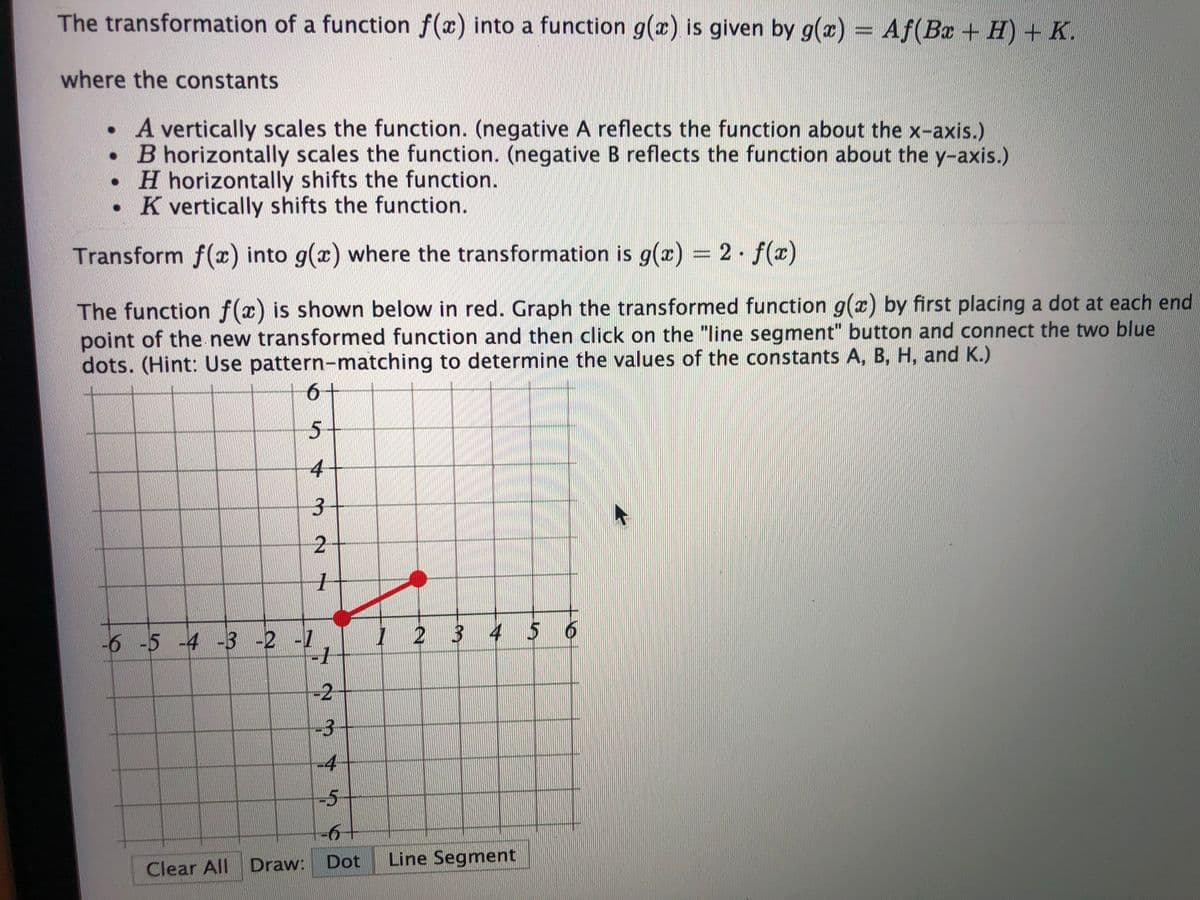The transformation of a function f(x) into a function g(x) is given by g(x) = Af(Bx + H) + K. where the constants A vertically scales the function. (negative A reflects the function about the x-axis.) B horizontally scales the function. (negative B reflects the function about the y-axis.) • H horizontally shifts the function. • K vertically shifts the function. Transform f(æ) into g(x) where the transformation is g(x) = 2· f(x) %3D
The transformation of a function f(x) into a function g(x) is given by g(x) = Af(Bx + H) + K. where the constants A vertically scales the function. (negative A reflects the function about the x-axis.) B horizontally scales the function. (negative B reflects the function about the y-axis.) • H horizontally shifts the function. • K vertically shifts the function. Transform f(æ) into g(x) where the transformation is g(x) = 2· f(x) %3D
Chapter3: Functions
Section: Chapter Questions
Problem 8PT: For the following exercises, evaluate the function f(x)=3x2+2x at the given input. 8. Graph the...
Related questions
Question

Transcribed Image Text:The transformation of a function f(x) into a function g(x) is given by g(x) = Af(Bx + H) + K.
where the constants
A vertically scales the function. (negative A reflects the function about the x-axis.)
•B horizontally scales the function. (negative B reflects the function about the y-axis.)
•H horizontally shifts the function.
•K vertically shifts the function.
Transform f(¤) into g(x) where the transformation is g(x) = 2· f(x)
The function f(x) is shown below in red. Graph the transformed function g(x) by first placing a dot at each end
point of the new transformed function and then click on the "line segment" button and connect the two blue
dots. (Hint: Use pattern-matching to determine the values of the constants A, B, H, and K.)
-6 -5 -4 -3 -2
I 2 3 4 5 6
-2
-3
Dot
Line Segment
Clear All Draw:
Expert Solution
This question has been solved!
Explore an expertly crafted, step-by-step solution for a thorough understanding of key concepts.
This is a popular solution!
Trending now
This is a popular solution!
Step by step
Solved in 2 steps with 1 images

Knowledge Booster
Learn more about
Need a deep-dive on the concept behind this application? Look no further. Learn more about this topic, advanced-math and related others by exploring similar questions and additional content below.Recommended textbooks for you


Algebra & Trigonometry with Analytic Geometry
Algebra
ISBN:
9781133382119
Author:
Swokowski
Publisher:
Cengage

Glencoe Algebra 1, Student Edition, 9780079039897…
Algebra
ISBN:
9780079039897
Author:
Carter
Publisher:
McGraw Hill


Algebra & Trigonometry with Analytic Geometry
Algebra
ISBN:
9781133382119
Author:
Swokowski
Publisher:
Cengage

Glencoe Algebra 1, Student Edition, 9780079039897…
Algebra
ISBN:
9780079039897
Author:
Carter
Publisher:
McGraw Hill

Algebra and Trigonometry (MindTap Course List)
Algebra
ISBN:
9781305071742
Author:
James Stewart, Lothar Redlin, Saleem Watson
Publisher:
Cengage Learning

Big Ideas Math A Bridge To Success Algebra 1: Stu…
Algebra
ISBN:
9781680331141
Author:
HOUGHTON MIFFLIN HARCOURT
Publisher:
Houghton Mifflin Harcourt

Algebra: Structure And Method, Book 1
Algebra
ISBN:
9780395977224
Author:
Richard G. Brown, Mary P. Dolciani, Robert H. Sorgenfrey, William L. Cole
Publisher:
McDougal Littell